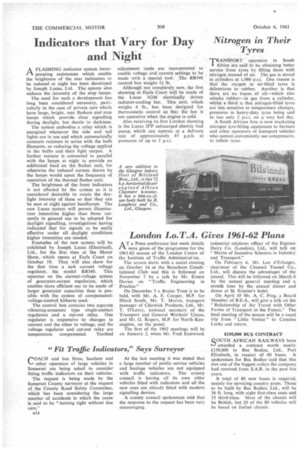Indicators that Vary for Day and Night
Page 48

If you've noticed an error in this article please click here to report it so we can fix it.
A FLASHING indicator system incorrt porating resistances which enable the brightness of the rear indicators to be reduced at night has been developed by Joseph Lucas, Ltd. The system also reduces the intensity of the stop lamps.
The need for such a development has long been considered necessary, particularly in the case of private cars which have large, bright, rear flashers and stop lamps which provide clear signalling during daylight, but dazzle in darkness. The system embodies a relay which is energized whenever theY side and tail lights are in use and which automatically connects resistors in series with the bulb filaments, so reducing the voltage applied to the bulbs and their light output. A further resistor is connected in parallel with the lamps at night to provide an additional load on the flasher unit, for otherwise the reduced current drawn by the lamps would upset the frequency of operation of the thermal flasher unit.
The brightness of the front indicators is not affected by the system as it is considered desirable to retain the day light intensity of these so that they can be seen at night against headlamps. The new Lucas system will permit illumina tion intensities higher than those currently in general use to be adopted for daylight signalling, investigations having indicated that for signals to be really effective under all daylight conditions higher intensities are needed.
Examples of the new system will be exhibited by Joseph Lucas (Electrical), Ltd., for the first time at the Motor Show, which opens at Earls Court on October 18, They will also show for the first time a new current voltage regulator, the model RB340. This operates on the current-voltage system of generator-output regulation, which enables more efficient use to be made of' larger generator capacities than is possible with the system of compensatedvoltage-control hitherto used.
The control box contains two separate vibrating-armature type single-contact regulators and a cut-out relay. One regulator is responsive to changes in current and the other to voltage, and the voltage regulator and cut-out relay are temperature compensated. Toothed
adjustment cants are incorporated to enable voltage and current settings to be made with a special tool. The RB340
control box weighs lb.
Although not completely new, the first showing at Earls Court will be made of the Lucas 3GM electrically driven radiator-cooling fan. This unit, which weighs 4 lb., has been designed for thermostatic control so that the fan is not operative when the engine is cold.
Also receiving its first London showing is the Lucas 2FP submerged electric fuel pump, which can operate at a delivery rate of approximately 45 g.p.h. at pressures of up to 5 p.s.i.




























































































































































